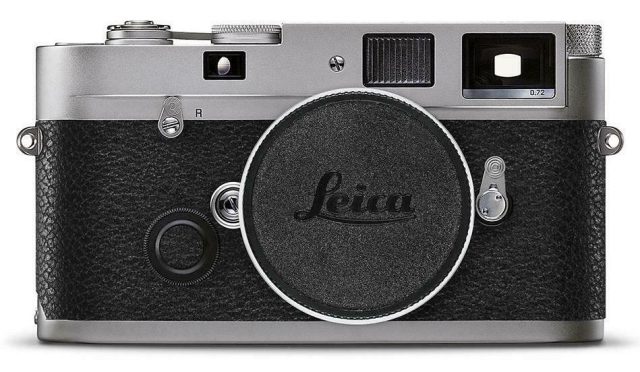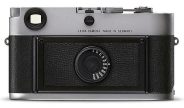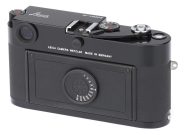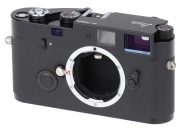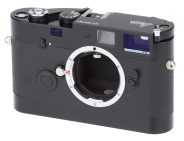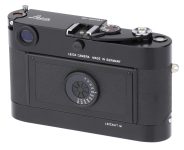Announced
Production status
Order No.
System
Downloads
Leica M system cameras
- Leica M (Typ 240)
- Leica M (Typ 262)
- Leica M Monochrom
- Leica M Monochrom (Typ 246)
- Leica M-A (Typ 127)
- Leica M-D (Typ 262)
- Leica M-E (Typ 220)
- Leica M-E (Typ 240)
- Leica M-P (Typ 240)
- Leica M1
- Leica M10
- Leica M10 Monochrom
- Leica M10-D
- Leica M10-P
- Leica M10-R
- Leica M11
- Leica M11 Monochrom
- Leica M11-P
- Leica M2
- Leica M3
- Leica M4
- Leica M4-2
- Leica M4-P
- Leica M5
- Leica M6
- Leica M6 (Typ 2248)
- Leica M6 Panda
- Leica M6 Titanium
- Leica M6 TTL
- Leica M6J
- Leica M7
- Leica M8
- Leica M8.2
- Leica M9
- Leica M9-P
- Leica MD
- Leica MD-2
- Leica MDa
- Leica MP
- Leica MP Original
Leica MP
35mm MF film rangefinder camera
Specification
| Format: | |
| 35mm full frame | |
Film type: | 135 cartridge-loaded film |
| Leica M [27.8mm] | |
| Shutter: | |
Type: | Focal-plane |
Model: | Mechanical |
Speeds: | 1 - 1/1000 + B |
| Exposure: | |
Exposure metering: | Through-the-lens (TTL), stop-down |
Exposure modes: | Manual |
| Rangefinder and Viewfinder: | |
Rangefinder: | Built-in, combined with viewfinder |
Viewfinder: | Built-in, combined with rangefinder |
Finder magnification: | 0.58x |
| 0.72x | |
| 0.85x | |
Actual rangefinder base: | 69.25mm |
Effective rangefinder base: | 40.17mm - with 0.58x |
| 49.86mm - with 0.72x | |
| 58.86mm - with 0.85x | |
Bright-line frames: | 28mm & 90mm, 35mm, 50mm & 75mm - with 0.58x |
| 28mm & 90mm, 35mm & 135mm, 50mm & 75mm - with 0.72x | |
| 35mm & 135mm, 50mm & 75mm, 90mm - with 0.85x | |
Parallax compensation: | Yes |
| Physical characteristics: | |
Weight: | 585g |
Dimensions: | 138x77x38mm |
| Accessories: | |
Body cap: | 14195 |
| 14397 |
Manufacturer description #1
03 - 03/2003 - LEICA MP
Leica Camera AG of Solms, Germany, is proud to announce the LEICA MP, a new tool for professional and dedicated amateur photographers. This purely mechanical rangefinder system camera is tailored entirely to the precise manual control of the photographically important parameters of time, aperture and focal plane. The photographer is not given any support, nor is he distracted by automatic program controls or options. If the photographer selects the shutter speed and the aperture, he or she will be completely independent of batteries. Rangefinding and exposure metering are of the very highest precision and have again been optimized. The new LEICAVIT-M accessory permits rapid manual film advancing. Virtually all system components of earlier models can also be used on the new camera.
All the functions of the new LEICA MP are designed for absolute ruggedness and longevity. Like all Leica system cameras, the LEICA MP is assembled with manual craftsmanship in Solms in central Germany. The pull-up rewind knob is easy to grip and, like the film advance lever, is entirely made of metal, which makes both elements impact-resistant. The camera top is milled from solid brass. “For the owner, this means dependability during decades of hard use as well as high value retention. The LEICA MP is not a photographic infatuation – it is a camera for life,” according to Jean-Jacques Viau, marketing manager of the system products business unit of Leica Camera AG.
The LEICA MP replaces the LEICA M6, whose production was discontinued in early 2003 after a highly successful run of 19 years. At the same time, the LEICA MP complements the LEICA M7, which was introduced in 2002 and has an electronically controlled shutter and aperture-priority automatic exposure control for greater convenience and more functions.
By using less electronics as compared to the LEICA M6 TTL and the LEICA M7, it was possible to reduce the height of the top cover of the LEICA MP by 2.5 mm. This further enhanced the new camera’s discretion and compactness, for which the Leica M system is renowned.
Additional characteristics of the LEICA MP are the new sure-grip leather covering and the absence of the familiar red Leica dot on the front of the camera. “Although many photographers love the red Leica dot, they nevertheless discreetly cover it up on their M cameras in order to be able to work as inconspicuously as possible. That is why we decided to leave it off the new LEICA MP right from the start. We believe that it is sufficient that connoisseurs and owners recognize the camera as a Leica,” says Jean-Jacques Viau. In addition to the silver chrome version of the LEICA MP, the camera is also regularly available in a black lacquer version. After intensive prolonged use, some corners and edges will wear down to the solid brass. Many photographers value this as a reminder of the many experiences they have shared with the camera,“ says Jean-Jacques Viau.
The name MP, which was already used for an earlier model, signifies that this is one of the Leica M cameras that have been specially designed to address the needs of professional photographers. “The Leica MP offers 'Mechanik in Perfektion' - the second meaning of the letters MP,“ says the CEO of Leica Camera AG, Hanns-Peter Cohn. “We see the LEICA MP as an antithesis to the trend towards digitization and automation. In our experience, it is not the functions and facilities of a camera that determine the real quality of an image. The most important factor is the person behind the viewfinder who sees, composes and captures. Not forgetting the quality of the lens, of course, which is the actual producer of the image. As the camera is unpretentious and discreet, it offers the photographer a longlasting harmonious and inspiring relationship,“ says Cohn.
Shutter: The LEICA MP features a mechanically controlled horizontal-action, rubber-cloth focal- plane shutter, which is extremely precise, quiet and vibration-free. Shutter speeds of 1 to 1/1000s can be preselected in whole steps on the speed setting button on the camera top. The “B“ setting is for long exposures of any duration. The delay is extremely short, making shutter release much quicker than that of a usual SLR camera. This is a crucial advantage for capturing the 'magic moment' that is the hallmark of a special photograph.
Rangefinder system: The LEICA MP integrates the top-precision rangefinder system of all Leica M cameras, which features a large, bright viewfinder with automatic parallax compensation. The field of view is indicated by pairs of bright-line frames, either for 28 and 90mm (90mm frame separately in the LEICA MP 0.85), for 35 and 135mm (35mm frame separately in the LEICA MP 0.58) or for 50 and 75mm. The corresponding frames are mechanically reflected into the viewfinder when the lens is attached. With the aid of the field-of-view selector, any required frame can be displayed. To enhance contrast and brightness, all the optical surfaces of the viewfinder have been given a multi-layer anti-reflection coating. Even with particularly critical side light, the viewfinder provides a high-contrast metering field and clearly visible frames for each focal length due to a modified mirror and an additional lens. The split- and coincident-image rangefinder allows fast and spot-accurate focusing in all conditions. Unlike SLR systems, in which the measuring base is determined through the lens by the focal length and the lens speed, the measuring base of the LEICA MP rangefinder is always the same whatever lens is used. Its focusing accuracy, particularly for short focal lengths, is therefore clearly superior to that of SLR cameras.
Exposure metering: The selective through-the-lens exposure metering of the LEICA MP leads to the same precise results as with the LEICA M6 TTL. Even against-the-light situations, spotlight illumination or glancing side light, which cause different colors, light intensities and contrasts, are effectively mastered. Measurement is activated by exerting slight pressure on the shutter release. The light reflected by a white patch on the shutter curtain is measured by a photo diode via a collector lens. Thanks to its extraordinary sensitivity (a light value higher), this measuring method can even be used in candlelight. A battery status indicator in the viewfinder signalizes a decrease in the operating voltage.
Mechanical components: The reliability of the mechanical components of the LEICA MP was verified in numerous laboratory and field tests before the market launch. Like the LEICA M7, the LEICA MP has a top of solid brass. The main body and housing consist of light-weight but robust diecast aluminum. All the controls such as the speed dial, the film advance lever and the rewind crank are made entirely of metal.
Because of the camera's sturdiness and reliability, Leica Camera AG is giving registered owners a special 5-year warranty on the LEICA MP. On top of this, the company guarantees the availability of all services and spare parts in Leica after-sales service for at least thirty years after a possible change of model.
The two lenses LEICA SUMMICRON-M f/2/35 mm and LEICA SUMMILUX f/1.4/50 mm are also available in a black lacquer finish to match the black lacquered LEICA MP.
The first supplies of the LEICA MP will be available at Leica stockists' from March 2003. There are four different versions: the black lacquer model with 0.72x viewfinder magnification and the silver-chrome models with 0.58x, 0.72x and 0.85x magnification.
Manufacturer description #2
Mechanical perfection. Nothing else. The LEICA MP is a tool. Made by hand, created for the photographer’s craft. Tailored to the decisive photographic parameters. In compact form, with clean design, clearly laid out. Unobtrusive, quiet, reliable. Concentrated technology for concentrated photography, without distraction by automation. For pictures that only a photographer can see, compose and record. Modern, because it captures the present. Current, because all its features have been optimized. Traditional, because it builds on the accumulated experiences of the pioneer in 35 mm camera construction. Not a photographic whim, but a camera for life.
With the name MP, the new Leica rangefinder camera joins the line of reporter cameras that have been tailored specifically to the wishes of professional photographers. It is the purely mechanical alternative to the LEICA M7, whose electronically controlled shutter and aperture-priority automatic exposure control offer more convenience and functions. The LEICA MP is dependent upon the skill of the photographer, but independent of, for instance, batteries. The latter are only needed for exposure metering. Those who set shutter speeds and apertures themselves can dispense with the electronics altogether.
All control elements are made completely of metal. The pull-up rewind knob is especially handy and impact-resistant. And because many pros love the red Leica dot, but discreetly cover it up on their cameras, we have dispensed with this round logo right from the start. We believe that it is sufficient that knowledgeable photographers and owners readily identify the Leica as such. The delicate Leica script on the top cover is an adequate reminder.
The LEICA MP is available in two different surface finishes: in silver chrome finish and in black lacquer finish. And when, after prolonged intensive use, the black lacquer wears down to the bare brass on some edges and corners, the photographer will know that he or she has shared many memorable experiences with that camera.
The LEICA MP with the silver chrome finish is available with the three viewfinder magnifications of 0.58 x, 0.72 x, and 0.85 x. It is tailored ideally to the preferences and needs of the photographer: The 0.58 x magnification for a great overview with wide-angle lenses and for eyeglass wearers. 0.72 x as a universal standard (also featured on the black lacquer version). 0.85 x for accurate focusing with medium focal length lenses and with Leica M tele lenses. The new body covering with its very good grip is common to all versions.
Photography means writing with light. Photography with a Leica M also means being able to create dramatic images even in low available light situations. Lenses that deliver rich contrast and full performance at full aperture, focusing with pinpoint accuracy with the Leica rangefinder and the vibration-free release of the cloth focal plane shutter are the basis for that capability.
Difficult light situations can be mastered accurately with the LEICA MP, because the camera does not attempt to think on behalf of the photographer. Instead, its selective exposure metering provides the photographer with accurate, unequivocal data on which he can base his decisions. The LEICA MP goes a step further with a newly improved viewfinder: A new type of mirror and an additional lens element present a measuring field rich in contrast and clearly delineated bright-line frames for the various focal lengths, even with particularly critical lateral light.
The LEICA MP has been designed for longevity and value retention. To that end, we only use selected materials and sophisticated fabrication processes. Before it was ready to be marketed, the LEICA MP was subjected to numerous and exhaustive field- and laboratory tests to prove its solidity. In extremely cold temperatures, in which no battery-dependent camera would function any longer. With shutter release cycles in numbers that hardly any other camera can sustain. Therefore Leica is offering an unusually long warranty period of 5 years for registered owners, who acquired their LEICA MP at an authorized dealer.
From today’s point of view we cannot imagine that the LEICA MP can ever be improved. Nevertheless we do guarantee that all services and spare parts will be available at Leica customer service departments for at least thirty years after a possible model change.
Manufacturer description #3
The Leica MP is built for long life and lasting value. This is guaranteed by Leica’s commitment to using only the finest materials and the highest precision manufacturing techniques. Time and time again, the Leica MP has proven its dependability under the most averse conditions.
The Leica MP’s strong body – crafted exclusively in metal – will withstand the worst conditions without fail, and batteries are only needed for metering. In fact, skilled photographers can ignore the electronics completely. Uncompromising dependability for all occasions.
By definition, photography is writing with light, and the Leica MP enables the photographer to master even the most difficult lighting situations. The camera offers you complete creative control; its selective TTL metering system merely offers supporting data to help you choose the ideal exposure parameters.
The Leica MP is available in two different body finishes: silver chrome and black paint. After years of hard use, when a bit of bright brass begins to show through, it’s a sure sign to savvy photographers that the camera and its owner have shared many memorable experiences.
Most professionals love the red Leica dot on their cameras, but for the sake of maintaining a low profile, the Leica MP was manufactured without this iconic emblem. Of course, knowledgeable owners and aficionados can identify a Leica anywhere without the need for special branding. The Leica inscription on the top deck is identification enough.
Special editions (18)
- Leica M3 J (200 units) - April 2006
- Leica M3-P "20 Years Leica Shop Vienna" (20 units) - June 2011
- Leica MP 3 "LHSA Special Edition" (1500 units) - 2005
- Leica MP 6 (400 units) - February 2003
- Leica MP Anthracite (600 units) - July 2004
- Leica MP Classic (500 units) - December 2004
- Leica MP Gold (1 unit) - 2020
- Leica MP Gold "60 years PRC" (60 units) - 2009
- Leica MP Oliv (100 units) - March 2014
- Leica MP Titanium "Leica Store Ginza" (150 units) - April 2007
- Leica MP "60th Jubilee of Korean Independence" (60 units) - August 2005
- Leica MP "70th Anniversary Republic of Korea" (70 units) - 2015
- Leica MP "Edition Hermès" (500 units) - October 2003
- Leica MP "Leica HISTORICA 1975-2020" (45 units) - 2020
- Leica MP "LHSA 1968-2003" (1000 units) - September 2003
- Leica MP "Meister Edition Berlin" (10 units) - March 2017
- Leica MP "Republic of China Centennial" (100 units) - March 2012
- Leica MP "Terry O’Neill" (35 units) - May 2018
Similar cameras (13)
35mm full frame • Manual focus • Film • Rangefinder • Leica M mount
| Model | Shutter | Metering | Modes | Year |
|---|---|---|---|---|
| Cosina Voigtlander BESSA-R2 | M, 1/2000 | TTL • WA | M | 2002 ● |
| Cosina Voigtlander BESSA-R2A | E, 1/2000 | TTL • WA | AM | 2004 ● |
| Cosina Voigtlander BESSA-R2M | M, 1/2000 | TTL • WA | M | 2006 ● |
| Cosina Voigtlander BESSA-R3A | E, 1/2000 | TTL • WA | AM | 2004 ● |
| Cosina Voigtlander BESSA-R3M | M, 1/2000 | TTL • WA | M | 2006 ● |
| Cosina Voigtlander BESSA-R4A | E, 1/2000 | TTL • WA | AM | 2006 ● |
| Cosina Voigtlander BESSA-R4M | M, 1/2000 | TTL • WA | M | 2006 ● |
| Cosina Voigtlander BESSA-T | M, 1/2000 | TTL • WA | M | 2001 ● |
| Konica HEXAR RF | E, 1/4000 | TTL • WA | AM | 1999 ● |
| Leica CL aka LEITZ minolta CL |
M, 1/1000 | TTL • WA | M | 1973 ● |
| Minolta CLE | E, 1/1000 | TTL • WA | AM | 1980 ● |
| Rollei 35 RF | M, 1/2000 | TTL • WA | M | 2002 ● |
| Zeiss Ikon | E, 1/2000 | TTL • WA | AM | 2004 ● |
